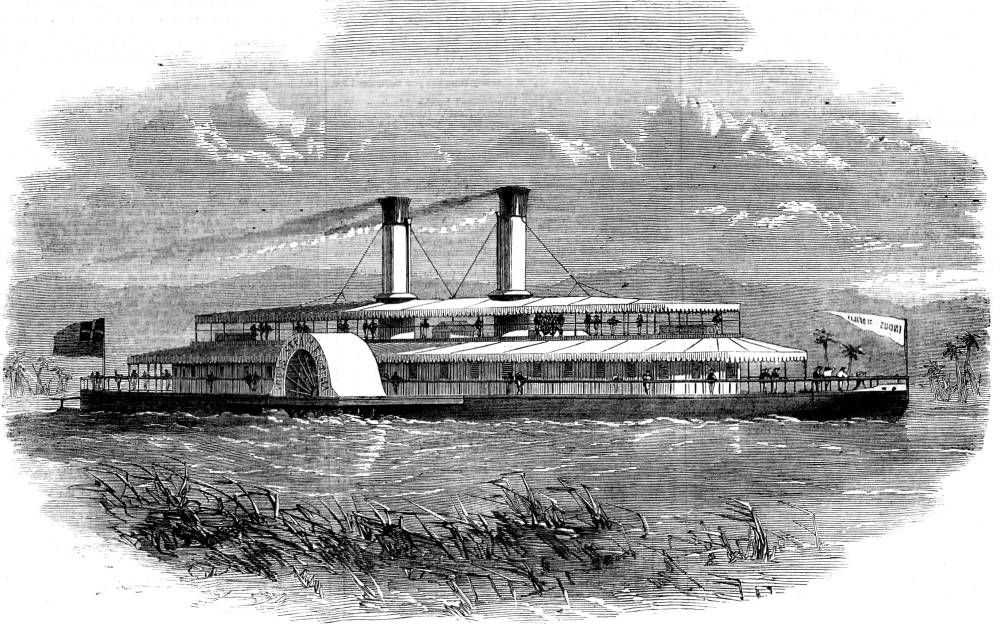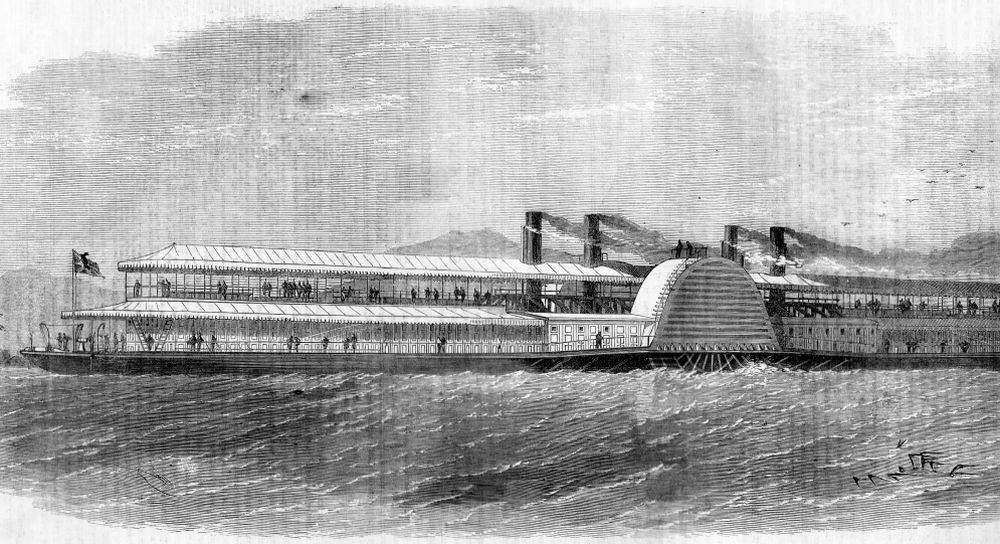paddlesteamers.info : The Internet's leading website for
Side-Wheeled Paddle Steamers
INDIA (now PAKISTAN) : River Indus
After the British captured Karachi in 1839 and the rest
of the Sind in 1843, the main objective was to forge a new route into
northern India, to Amritsar and ultimately, Delhi. Karachi
was seen as a particularly fine harbour, the closest on the
sub-continent to Europe and likely to grow to be the largest port for
importing and exporting. Unlike other major
rivers such as the Ganges and the Irrawaddy in Burma, the era
of paddle steamer operations on the Indus was short and the number
of vessels employed limited. The river proved difficult to navigate but
the main contributing factor was the comparatively early
development of a railway along the same route.
The first steam navigation of part of the river is attributed to the paddler Indus in 1835, captained by John Wood.
A small flotilla (the Indus Flotilla) was
based at Kotri on the opposite bank of the river to the Sindh capital
of Hyderabad which was effectively the lower limit of navigation for
larger vessels due to the problems navigating the strands of the Indus
delta. The flotilla fulfilled a number of roles, including military,
for which they were fitted with cannons. The steamers were owned
by the East India Company, who in effect managed the Indian
territories of the British Empire, and sailed from Karachi to Multan
but rarely
any further upstream. Transit times were around 12 days downstream and
25 days upstream.
Steamships required to be of a very
shallow draught to be able to navigate the shallows and shifting snads
of the Indus. William Laird and son John of Wallasey and later
Birkenhead became specialists in this type of vessel and were the
primary supplier to the East India Company.
The
construction of a railway from Karachi to Kotri was authorised by the
East India Company in 1855 and this would considerably improve transportation
time on the Indus route by eliminating the tortuous paths through the
Indus Delta which could only be transited by small local sailing boats
which had to trans-ship their goods at Kotri. The 700-mile up-river haul
to Multan which was the most easily navigable part of the entire route
and for which the Indus Steam Flotilla
was established in association with the Scinde Railway and the Punjab
Railway (which was constructing the onward route from Multan).
The railway link from Karachi to Kotri was opened in
1861.
One consequence of the rebellion was the removal of the East
India Company from its quasi-independent administrative role following
criticism of its handling of affairs in the area, the reduction of the
number of vessels staioned at Kotri and disbandment of the entire fleet by 1861, and the vesting of the remaining
vessels in the new Indus Steam Flotilla.
In 1869 the Indus Steam Flotilla became officially part of the newly amalgamated Scinde, Punjab & Delhi Railway,
shortly after the railway reached Multan. With the railway reaching
Lahore by 1878, river paddle steamers were all but redundant, limited
to providing a river crossing on the Lahore leg which did not receive
the necessary bridge for a further ten years.
The Oriental Inland Steam Navigation Company had
been established in 1856 by John Wood, the pioneer navigator from
1835, to provide a freight and passenger service on the Indus (and
other rivers in British India) but without success especially after the
railway to Kotri was opened. It could not compete with the Indus
Flotilla, attempted to come into som accommodation with it but went
into liquidation in 1867.
Names
for the early Indus vessels appear to have been as shown
below and were mostly built by Laird at Wallasey and shipped out
in kit form for reassembly at Bombay
350 ton vessels
Indus
Planet
Satellite
Meteor
Comet
200 ton vessels
Napier
Meanee
Conqueror
Assyria
Nimrod
Satellite (II)
500 ton vessels
Indus (II) (1851)
Jhelum (1851)
Chenab (1851)
600 ton vessels built at Laird's new Birkenhead yard which were still being reconstructed in Bombay when the Mutiny erupted
Frere (1856)
Havelock (1856)
Outram (1856)
Sir Henry Lawrence (1856)
It
is not known what subsequent paddle steamers were built for service on
the Indus. William Andrew, first chairman of the Scinde Railway,
proposed fifteen new paddle steamers in 1856, with five being delivered
per year along with the associated dumb barges for cargo. The
British Governement created a commission to investigate suitable
designs for developing trade and moving troops along the Indus, taking
advice from established shipbuilders and engineers.
The
Indus Steam Flotilla definitely took delivery of a new vessel designed and built
by John Scott Russell engineer and shipyard owner at Millwall, London. The yard had recently
completed construction of the Great Eastern designed by IK Brunel, the
largest paddle stemer ever built. It is believed to have been 200 ft long and known as Pioneer. There
is one representation of what is believed to be Pioneer which
is published on-line showing her in operation for the Indus Steam
Flotilla (see below) from a contemporary report in the Illustrated London News.

Although
not of the scale of Great Eastern, the commission was to be the
promoter of an experimental new design of shallow-draught river steamer
which was to be the longest paddle stemer ever built by a British yard.
Designed by TB Winter, Talpore
was built in Stockton,
dismantled and rebuilt to undertake trials on the Thames off Gravesend
and dismantled once more for shipment to Bombay. This and the vessel
itself is described in detail in a report in the Illustrated London
News in 1861. Exactly what happened
after that is unclear. Conflicting reports show her as having broken
her back on the sea voyage from Bombay to Karachi. Another has her
serving on the Indus for around twenty years.
There
is only one
artistic representation of Talpore which is publicly available (see
below, from the Illustrsated London News) although there is
also one model of her in the Preston Hall museum in Stockton. The
background is clearly not the Thames but the ILN article appeared some
time before she would have been reconstructed for use on the Indus.

Talpore
Built
by Matthew Pease & Lockwood at Stockton-on-Tees with engines by
James Watt & Co of Birmingham (Horizontal 55 x 72 in).
377 x 42 ft : 739 GRT
Draught 2 ft
Dismantled
and rebuilt before she underwent trials on the Thames at Gravesend in
1861 before being dismantled once more and shipped to Bombay
Designed to carry eight hundred troops plus officers in cabins or 3000 troops otherwise
Special strengthening (hogging) trusses were provided to strengthen the long but extremely shallow-draughted vessel
Fresh moist air was pumped to the cabins by a steam pump
The handrails were tubular, designed to operate a speaking tubes for communication with the engine room
For
commercial service it appears that there were further deliveries of up
to six (with attendant dumb barges) from Richardson, Duck of
Stockton-on-Tees.
Return to
Historical Database

